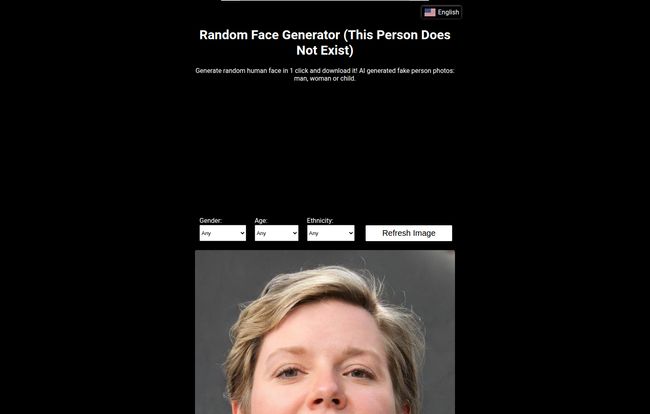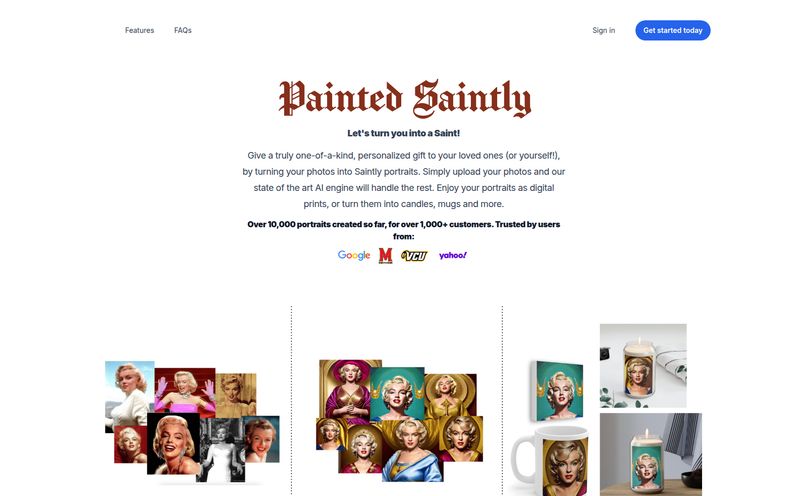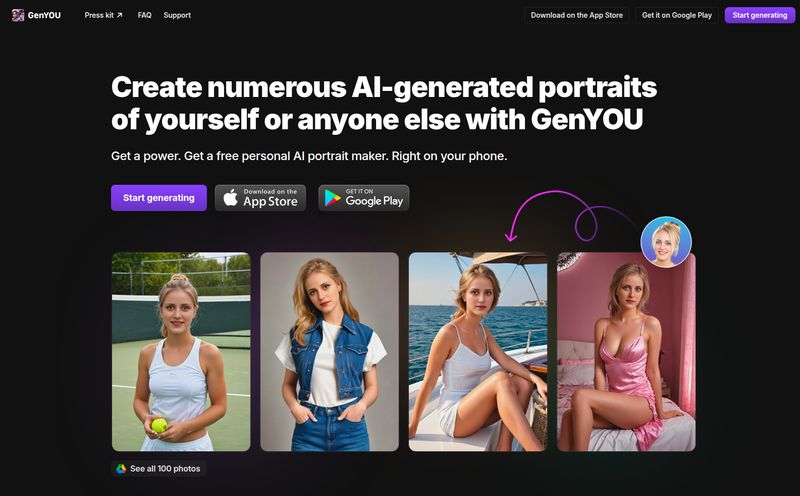As SEOs and digital marketers, we live in a world of personas. We have 'Marketing Mary,' a 35-year-old project manager who loves yoga and organic coffee. We have 'Tech-Savvy Tom,' the 22-year-old college student who codes in his sleep. We build entire strategies around these imaginary people. But when it comes to putting a face to the name for a presentation or a mockup... well, that's when you enter the ninth circle of stock photo hell.
You know the drill. Endless scrolling through cheesy, over-lit photos of 'Businesswoman Laughing Alone With Salad.' It’s a pain. So when I first stumbled upon This Person Does Not Exist a few years back, I was floored. A single click, and poof. A new human face, generated out of thin air by AI, staring back at me. No cheesy smiles, no salad. Just... a person. Except, they're not a person at all.

Visit This Person Does Not Exist
So, What Exactly Is This Sorcery?
At its core, This Person Does Not Exist is a website that does one thing and does it incredibly well: it generates photorealistic, but completely fake, human portraits. It’s powered by a type of neural network called a StyleGAN, which was originally developed by the researchers at Nvidia. Think of them as the wizards behind the curtain.
I’ve spent more time than I'd care to admit just hitting the 'Refresh Image' button, mesmerized. You can even filter by gender, age range, and ethnicity to get closer to the persona you're building. One minute you get a sweet-looking old lady who looks like she bakes killer cookies, the next you get a brooding twenty-something who probably has a podcast about indie films. It’s endlessly fascinating.
The Nerdy Part: How GANs Actually Work
Okay, stick with me here. The tech behind it is called a Generative Adversarial Network, or GAN. The easiest way to think about it is like a high-stakes game between two AIs: an art forger and an art critic.
- The Generator (The Forger): This AI’s job is to create a fake face from scratch. At first, its attempts are garbage—just a mess of pixels.
- The Discriminator (The Critic): This AI has been trained on thousands of photos of real people. Its job is to look at the forger's work and call out the fakes.
Every time the critic spots a fake, the forger learns from its mistakes and gets a little bit better. They go back and forth millions of times, with the forger getting progressively more skilled at creating believable faces, and the critic getting better at spotting even the tiniest flaws. Eventually, the forger gets so good that the critic can no longer reliably tell the difference. And that’s when you get the hyper-realistic images you see on the site. It’s a digital duel to the death, and the prize is a face that has never existed.
How to Become a Fake-Face Detective
As cool as this tech is, it's not perfect. Once you know what to look for, you can start spotting the AI's little slip-ups. It becomes a fun little game of 'spot the fake.' The AI is so hyper-focused on making the central parts of the face—eyes, nose, mouth—look perfect that it often gets lazy with the details.
Here are the biggest giveaways I’ve noticed:
- Funky Backgrounds: Look past the person. The background is often a swirly, distorted, nonsensical mess. A blend of a living room and a forest? Classic AI.
- The Ear Problem: Ears are complex. The AI often messes them up, creating strange shapes or making them asymmetrical. Same goes for earrings—you'll often see someone with two completely different earrings, or just one.
- Weird Teeth: Getting teeth right is tough. Sometimes you'll see teeth that look slightly out of alignment, or have strange, vampire-like sharpness.
- Glitches in the Matrix: Look for odd artifacts, like a chunk of hair that seems to dissolve into the background, a pair of glasses that are mangled, or weird smudges on the skin. It gives the whole thing a subtle 'uncanny valley' feel.
Once you see it, you can't unsee it. But for a quick mockup or a persona slide? Most people will never notice.
The Good, The Bad, and The Uncanny
Like any powerful tool, this one has its upsides and its pretty significant downsides. I've used it for a few things, and it’s been a lifesaver for quick, internal projects where we needed a face but didn't want to spend an hour on a stock photo site.
What I Love About It
The biggest pro is the sheer convenience. It's fast, it’s free (with conditions, more on that below), and it's dead simple to use. For creating a quick visual representation of a target demographic for a client presentation, it's brilliant. No more using that same, tired stock photo of 'Generic Office Worker #3'. The ability to tweak the age and ethnicity is also a huge plus for building more accurate and diverse user profiles.
What To Watch Out For
Now for the reality check. While the faces look real, they can have those weird AI artifacts that just make them look... off. This isn't something you'd want to use for a high-profile, public-facing campaign. The bigger issue, though, is the usage rights. The free version comes with a major string attached: you have to provide a backlink to their site. As an SEO, I appreciate the hustle, but it’s a critical detail for commercial projects. And then there's the big, looming ethical question. This technology can easily be misused to create fake social media profiles, spread disinformation, or create phony testimonials. It’s a powerful tool that requires a responsible user.
Let's Talk Money: The Pricing Breakdown
The pricing model is pretty straightforward, which I appreciate. You have two main options:
| Plan | Details | Cost |
|---|---|---|
| Free | Personal use only. Comes with a watermark, 512x512 resolution (JPEG), and requires a backlink if used online. | Free |
| Exclusive Use | No watermark, higher 1024x1024 resolution (PNG and JPEG). You get exclusive rights to that specific generated image. | $14.95 per image |
For my money, the free option is perfect for internal stuff—mood boards, persona documents, etc. If I ever needed one for a client's website mockup, I wouldn't hesitate to pay the $14.95 to get the high-res, watermark-free version and avoid any licensing headaches. Its a small price for peace of mind.
Frequently Asked Questions (The Stuff You're Probably Wondering)
- 1. Are these real people?
- Absolutely not. They are 100% computer-generated. They are statistical amalgamations of thousands of real photos, but the specific person you see has never existed.
- 2. Is it legal to use these images?
- Yes, it's legal. Since the person isn't real, there are no model releases or privacy rights to worry about. However, you MUST follow their terms of use—specifically the backlink requirement for the free photos. Misusing them for defamation or creating fake identities could land you in legal hot water for other reasons, though.
- 3. Can I use a generated face for my company's social media profile?
- I would strongly advise against this. Using a fake person to represent your brand feels deceptive. It's great for internal personas or abstract concepts, but not for representing your actual company or team. Authenticity is still king in marketing.
- 4. What is StyleGAN again?
- It's a type of Generative Adversarial Network (GAN) from Nvidia. It's the specific AI model that has been trained to be exceptionally good at creating realistic-looking faces. There are other GANs for creating art, landscapes, and even text, but StyleGAN is famous for its portraits.
- 5. Can I get the same face twice?
- The chances are astronomically small, basically zero. Each click generates a new, unique output from the neural network. If you find a face you like, you'd better download it, because you'll likely never see it again.
Final Thoughts on a Future Filled with Fake People
This Person Does Not Exist is more than just a cool tech demo; it’s a glimpse into the future of content creation. It’s a powerful, slightly unsettling, and incredibly useful tool for anyone in the digital space. It solves the very real problem of finding authentic-looking faces for our projects without the cost and cliche of traditional stock photography.
But it also serves as a reminder to keep our critical thinking hats on. As this technology gets better and more accessible, the line between real and synthetic will only get blurrier. For now, I'll keep using it for my persona maps and internal decks, and I'll keep playing 'spot the fake' just for the fun of it. It's a brave new world out there, and it’s full of people who were never even born.
Reference and Sources
- This Person Does Not Exist Official Website
- Pricing & Download Information
- Nvidia's StyleGAN on GitHub



